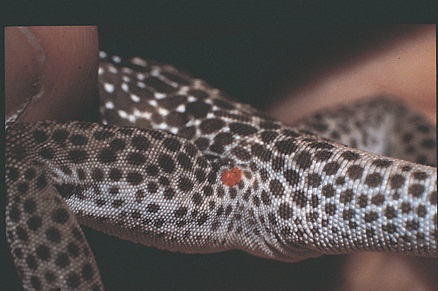Difference between revisions of "Reptiles and Amphibians Q&A 21"
(No difference)
| |
Latest revision as of 17:27, 28 October 2011
| This question was provided by Manson Publishing as part of the OVAL Project. See more Reptiles and Amphibians Q&A. |
The integument of this collared lizard has a red-orange mass on its surface.
| Question | Answer | Article | |
| What is your diagnosis? | Infestation with the trombiculid lizard mite, Herstiella trombidiiformis. Note the pointed protruberance at the caudal end of the mite’s abdomen; the presence of this structure helps differentiate this mite from Ophionyssus natricis. |
Link to Article | |
| What is its significance? | These ectoparasites cause local irritation induced by their bites and, therefore, provide an entry for pathogens into the irritated and inflamed integument. If large numbers of these mites are present, they can induce severe blood-loss anaemia. |
Link to Article | |
| How would you treat this condition? | Masses of these mites can be removed with a cotton-tipped applicator that has been moistened in an insecticide formulated to be safe for young puppies and kittens. After the masses of mites have been removed, the infested lizard should be wiped down with a cotton sponge barely moistened with the same insecticide. Lastly, the cage and all of its ‘furniture’ must be either discarded or thoroughly cleansed to eradicate any residual mites or their ova. |
Link to Article | |
